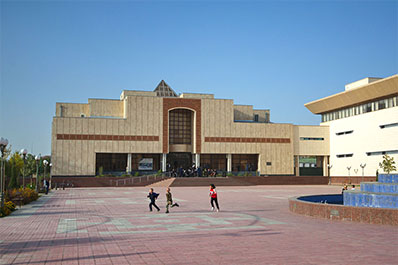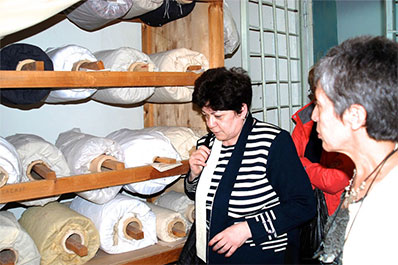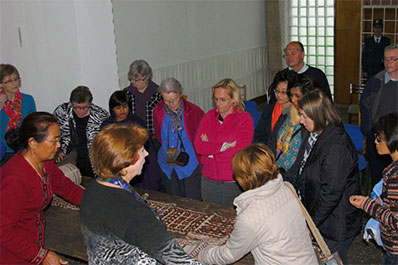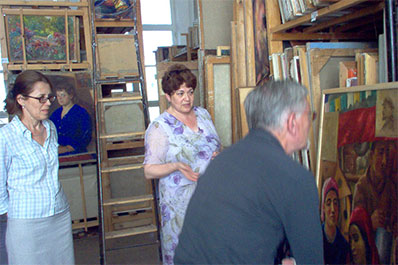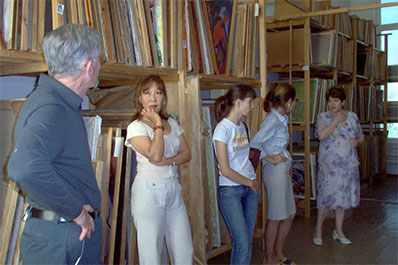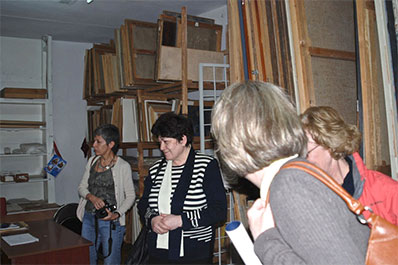Art connoisseurs will appreciate the hidden treasures of Savitsky Art Museum in Nukus, Uzbekistan, guardian of the world’s second-largest collection of Russian avant-garde art. Also known as Karakalpakstan State Museum of the Arts or Nukus Museum of Art, the little-known masterpieces in its storehouses were once referred to as the “Caves of Ali Baba” by a French ambassador. Surrounded in legend stemming from the museum’s history, visitors now have the unique opportunity of enjoying these rarely viewed artistic riches.
A typical visit to the temporary and permanent exhibits of Savistky Art Museum gives only a superficial introduction to the museum’s unique collection. Even a perusal of the dozen plus catalogs published throughout the museum’s existence (1966-present) will fail to provide an exhaustive understanding of the scale and quality of the diverse treasures contained at the museum. Despite the increase in exhibition halls, which were expanded in 2017 with the addition of a second exposition block, as of 2020 only about five percent of the museum’s relics were actually available for viewing.
In contrast, a visit to the depository allows the visitor to step out of the confines of a regular tour and the imposed tastes of the curator, a unique opportunity which is not offered elsewhere in Uzbekistan. Visitors to the storehouses will have the privilege of viewing works by artists who are not featured in the public exhibition halls, as well as special works holding scientific interest and ancient handmade textiles in the form of embroideries, costumes, woven garments and jewelry.
An excursion to the museum’s storerooms is an exclusive opportunity which may only be obtained with prior permission. The museum's depository building, located between two exhibition halls in the center of the museum, was designed specifically for storage, restoration workshops and the convenience of curators. It consists of three levels and has 2 elevators, one for passengers and one for freight. The architects designed the storerooms after a trip to Holland in 2012, where they studied advanced museum depositories and their security systems. Taking into account the global interest in the Savitsky museum collection, special rooms were subsequently designed for the ongoing work of researchers from all over the world.
Since many of the museum’s collections are not on display in the exhibit halls –including old Russian Orthodox icons, antique Russian and western European furniture, decorative and applied art and 1960s-1980s Uzbekistan paintings, among other items - a tour of the storehouses is a truly invaluable opportunity. Additionally, the applied art of early 20th-century avant-garde artists, etched in glass and plastic and based on the oeuvres of Vyacheslav G. Zimin, and the synthesis of sculpture and architecture in the works of sculptors such as M. Aisenstadt, remain in the storeroom and have yet to be thoroughly studied and published.
Of the more than two thousand works by Arkady Stavrovsky, only three are on display in the halls of Savitsky Art Museum. In contrast, several dozen of his masterpieces can be viewed in the stockroom. In 2018, a researcher from Moscow State University began long-awaited research on this artist at Savitsky Museum, and in 2020 her paper on Stavrovsky, based on the Nukus collection, became the first publication to highlight the artist. Similarly, the storeroom holds dozens of amazing works by Nikolai Tarasov, who was discovered by Igor Savitsky and produced more than 1100 works in his lifetime. Even in Russia, the artists’ homeland, the works of Tarasov and Stavrovsky cannot be found!
Of particular interest is a repository of graphics containing tens of thousands of drawings, watercolors and other works, a collection which international experts agree has yet to be fully appreciated. This brilliant collection is practically absent in the exhibition halls, with the exception of a scant few dozen works. Likewise, although archaeological displays are modestly represented in the public exhibits, tens of thousands of antique and medieval ceramics, bronze castings, coins and other artifacts may be viewed in the stockroom.
The firsthand account of Marinika Babanazarova, who personally knew Savitsky, worked alongside him in the storehouses and witnessed the evolution of its many exhibits and artists, will add a depth of richness to this unforgettable tour. While renowned world scientists spend 7 to 15 days among the hidden treasures of Savitsky Art Museum, we will spend one day immersed in this unique and incomparable adventure!


